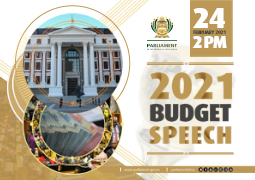
THE STATE OF THE NATION ADDRESS
The State of the Nation Address, which the President delivers to a joint sitting of the National Assembly and National Council of Provinces, announces government’s service delivery priorities for the year ahead.
Members of Parliament debate the President’s address over two days and the President then replies to issues raised in the debate. This process provides the representatives of the people with the opportunity to interrogate the content of the blueprint.
THE BUDGET
A few days after the debate on the President’s State of the Nation Address, the Minister of Finance delivers the Budget Speech and related Bills in the National Assembly.
The Budget Speech presents macrocenomic context and estimates government revenues and makes proposals about the details of how the priorities will be funded and the funds to be allocated to different spheres of government, departments and state entities.
Parliament interrogates the proposed allocation of funds to meet the priorities identified in the State of the Nation Address and must approve the National Budget, which the Minister of Finance tables, before it can be implemented.
SCRUTINY AND OVERSIGHT OF GOVERNMENT SPENDING
Parliament’s responsibility concerning the budget is an ongoing, rolling process throught out the financial year. Also taking into account that the budget provides for three year cycle ( MTEF).
Details of this process are set out in the Money Bills Amendment Procedure and Related Matters Act (Act 9 of 2009).
The Act has empowered Parliament to make amendments to the fiscal framework, appropriations and division of revenue and other money bills proposed by the Executive.
ADOPTING THE NATIONAL BUDGET
The fiscal framework sets out overall estimates of revenue collection, expenditure, borrowing, interest and debt servicing.
It provides context and motivation for government’s specific proposals about the Division of revenue Bill – which allocates funds to the national (including Parliament), the provincial and the local spheres of government.
It also provides motivation for the Appropriations Bill, which allocates funds to different national government departments and entities of the state – including Parliament.
The public, civil society and different entities through public hearings presents motivations and proposals to Parliament about why Parliament should approve or amend the budget proposed by the National Treasury.
Once Parliament has passed the Budget and Division of Revenue Bill for a particular financial year, Parliament deliberations the allocations to the different departments at separate sittings focusing on specific departments and their entities.
Parliamentary committees make decisions about the proposed allocations and present reports on them to the National Assembly for approval.
Once the National Assembly has approved the Fiscal Framework and Division of Revenue Bill, it considers the Appropriation Bill and votes on each departmental allocation. Once the National Assembly has adopted all Money Bills (Fiscal Framework, Division of Revenue and Appropriation Bill), it is transferred to the National Council of Provinces for concurrence.
WHAT HAPPENS AFTER THE NATIONAL BUDGET IS ADOPTED?
After Parliament has approved the National Budget, government departments and entities must provide a range of budget documentation to National Assembly committees.
These documents include strategic plans (every 5 years) annual performance plans and budgets including strategic goals and objectives. Reports on the implementation of budgets and plans are submitted quarterly for monitoring and evaluation of progress. An annual report is submitted at the end of the financial year.
The committees use the information to draw up Budgetary Review and Recommendation Reports (BRRRs) and table them in the National Assembly.
The BRRRs must give assessments of the service delivery performance of each government department, given available resources; and the effectiveness and efficiency of the departments’ use and further allocation of resources.
The BRRRs may include recommendations about the future allocation of resources to departments.
The BRRRs can help in making decisions about budget adjustments requested and the Minister of Finance must take them into account when developing the National Budget for the next financial year.
They must be submitted to the National Assembly after it has adopted the budget vote to which the BRRR applies and before the National assembly adopts reports on the Medium Term Budget Policy Statement.
THE MEDIUM TERM BUDGET POLICY PROCESS
In October, the Minister of Finance presents the Medium Term Budget Policy Statement.
This sets out government priorities for the next three years and tables the Adjusted Budget for the current year.
The Adjusted Budget includes a revised Fiscal Framework, a Division of Revenue Amendment Bill and an Adjustments Appropriation Bill.
The Adjusted Budget provides the Minister of Finance and Parliament with an opportunity to make adjustments to the budget for unforeseeable and unavoidable conditions.

